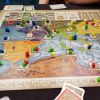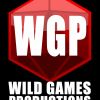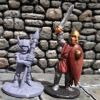Fringe Review: High Adventure Role Playing (HARP) from ZDL's blog
No history of RPGs would ever be complete without discussion of Iron Crown Enterprises' Rolemaster line of game products. Despite its many epithets (most notably Chartmaster)—whether justly or unjustly applied (and I feel largely unjustly!)—it is hard to deny the influence this game had on role-playing games in general and D&D in specific. First published in 1980 with the first component, Arms Law (a naming convention that set the table for all of the line), it began its existence as a replacement weapon/melee combat system for AD&D. (They couldn't state it that flatly, of course, for reasons of copyright, so it was "for RPGs".) It was rapidly followed with Claw Law (later packaged together) which added creature and unarmed combat to the mix. This was followed by Spell Law for magic and finally, in 1982, Character Law, turning Rolemaster from a set of supplements into its own independent role-playing game. 1984's Campaign Law was the final component (and one of the earliest guidebooks for world-building for GMs).
Rolemaster was a polarizing game from the start. Some praised its verisimilitude and consistency while others scourged its complexity and maths intensiveness. Personally I believe the latter group were just flat-out wrong. They didn't play the game and likely didn't read it very closely and were thus caught flat-footed by the huge number of tables involved assuming (incorrectly) that large numbers of tables meant large amounts of complexity.
This was wrong.
Yes the game could seem daunting when first encountered, but those who actually read (and more importantly PLAYED) the game understood that, while character generation and advancement (usually offline activities) could be convoluted and complicated, the system in use was astonishingly regular and simple – if you prepared in advance. What this meant in praxis is that each player should have a copy of the attack charts for their weapons and a copy of the general charts for skill resolution, criticals, and fumbles. With those in hand, most things players did were right in front of them and the game flew by quickly and smoothly. There was a small number of systems you had to remember: attack charts for weapons (all the same table structure with different numbers), static manoeuvres, moving manoeuvres, critical rolls and fumble roles. That's five core mechanisms which can be taught in ten minutes and they all used the same general roll: an "open-ended" d100 roll.
Still, there were two forces in favour of Rolemaster that kept it at the top of the heap of influential games (if not necessarily at the top in sales). First, those who were fans tended to be big fans. (Self included.) Second, Iron Crown Enterprises held the license to Middle Earth-related role-playing materials for YEARS, publishing a large line of setting information, adventures, and even a simplified version of Rolemaster called Middle Earth Role-Playing (a.k.a. MERP). This Middle Earth material was published with Rolemaster stats and given notes for conversion to "other" games (read AD&D) and thus served as a gateway drug for full-on Rolemaster play.
None of this, however, is the topic of this review.
HARP
All of the above aside, as is usual in this industry for all games (even the D&D line for a while, despite its externalities), the candle started to burn out and the game didn't shine so brightly any longer. Long viewed (unjustly, again, in my opinion) as too complicated, too difficult, and imposing to get into (this may have some justice), and viewed as especially imposing in character generation, impetus started to form around making a simpler game that was Rolemaster-compatible. It's design was to be kept around two watchwords: simplicity and flexibility. (Where the two clashed, flexibility was favoured.) Another important goal was that it was to be a single book that could be used without any others needed.
In late 2003, High Adventure Role Playing (HARP) was finally released to solid reviews both by fans of Rolemaster and, more importantly, by people who were not such fans. There was, however, an embarrassing number of typos and other errors in the game, so since the first run of the game sold out so quickly, a second printing/revised edition was released in early 2004 to fix those up. (People who owned the first edition got a free errata book.)
After this publication history gets muddled as Iron Crown Enterprises went through several periods of enormous financial difficulty, changed hands at least once, possibly twice, farmed out publication of some of its game lines to third parties like Guild Companion Publications, bought back at least some of those and finally, in 2011, a second edition published by GCP was released. In between HARP Sci-Fi was published by ICE (2008), a second edition of that, HARP SF was published by GCP (2010) and then an extra supplement, apparently never published for the first edition though it was supposed to have been, was published in 2011 called HARP SF Extreme.
Then, just to muddle things further, all of these are now sold under the heading of Iron Crown (not Iron Crown Enterprises).
This review will cover the first, revised edition of HARP. This is partially because it is the only edition I'm familiar with, and partially because it is sufficiently special to me that when I made my big move to China and had to get rid of most of my games, this edition of HARP is one of the very few physical RPG books that made the cut. (Most rules that I own nowadays are PDF versions because of space issues.) A quick glance over a summary of rules changes tells me that the game remains mostly unchanged in mechanism, however, with tweaks primarily around balancing specifics.
So without further ado, here is the review of HARP.
Components
HARP is, in its entirety, a 192-page softcover book. It has a very attractive (though also very late-90s, early-00s) piece of full colour cover art. The book itself is purely black & white on plain, matte paper stock. I bought my edition almost as soon as it was published in early 2004 and here in early 2020 it remains in decent shape with only one slightly troublesome point that shows the binding may finally have started to give out. Internal artwork ranges from the fair to the very good. Nothing stands out on either end of the quality scale. About a third of it seems evocative of the text around it and the rest is just more general mood-setting to show fantasy tropes: weapons, sigils, magic items, characters, etc.
Layout is clear, with simple page-edge iconography to help you figure out where in the book you are. Text is in two columns, and is a decent size even for my elderly eyes. It is consistently formatted so that it is easy to tell at a glance, on any page, what you're looking at and how it relates to other pieces of text. Tables are plain, have thick lines on the outside, and alternating grey and white backgrounds to make tracking horizontally much easier (especially important for some of the page-wide tables). A two-page table of contents opens the text and an 8-page index closes it. As with most books of the era, the index is of mixed utility. The game really could stand an external index done by a professional in the field. (Unfortunately small-press publishers generally cannot afford the kind of rates a first-class indexer can charge.)
Characters
Character creation proceeds in six steps. First step is the selection of a profession, one of: Cleric, Fighter, Harper (read: Bard), Mage, Monk, Ranger, Rogue, Thief and Warrior Mage. Professions are like classes in the D&D line, but rather than defining ability they define proclivity. All skills are open to all characters, but professions modify costs, grant free levels, etc. (That being said, if you're playing a fighter you'd have to be pretty stupid to pay the costs to learn magic skills…)
The second step is to generate statistics. There are several options for generating them, but in the end you have eight numbers, one each for: Strength, Constitution, Agility, Quickness, Self Discipline, Reasoning, Insight, and Presence. In D&D terms Agility and Quickness together would be Dexterity, Self Discipline and Insight together would be Wisdom, and Presence would be Charisma. Stats each have a bonus (which is the number used in actual play most times) and a number of development points they generate (the points used to purchase skills, talents, etc.). An unfortunate side effect of this is that someone who is lucky in generating statistics will grow more powerful more quickly as the game progresses.
The next step is to then select race and culture. Races are the usual mix of generic fantasy races: Human, Elf, Dwarf, Gnome, Halfling and "Gryx" (sort of like a mix of Klingons and Orcs). There's also the possibility of making a variety of half-blooded mixtures of these. The race you select may or may not limit what culture you choose. Cultures are Deep Warrens, Shallow Warrens, Sylvan, Nomadic, Rural, Urban, and Underhill. Races bring in special characteristics, abilities, advantages, and liabilities. Cultures provide initial adolescent skills.
Once stats are generated and profession, race, and culture selected, the first round of development points is used to buy skills and talents. (In D&D3 terms talents are something like feats. Unlike D&D3, talents are far simpler for the most part.) Skill bonuses from stats, race, culture, talents and skill levels are totalled and noted on the character sheet.
The final steps are buying initial equipment and rounding out the character to bring them to life.
General System
The HARP system, with a few minor exceptions, is largely based on percentile 1-100 rolls. In general higher is better. In some circumstances a variant called "open-ended rolls" is used in which a 1-100 roll is made, and if the result is 96-100, another 1-100 roll is made and added to the first. If this, in turn, is also 96-100, this is repeated until a number less than 96 is rolled. (For Rolemaster aficionados, this corresponds to an "open-ended high" roll. 01-05 is not treated specially as per Rolemaster "open-ended" or "open-ended low" rolls.)
Skills are rolled using an open-ended roll modified by the skill bonus calculated above. All-or-nothing rolls simply say that if the result is 101 or higher, success, otherwise failure. Manoeuvre rolls are rolled on a table and provide a percentage result that shows how much of the manoeuvre was completed (if applicable) or, for complementary skills, what bonus use of the skill applies to the next skill being tested. The same roll and table is used for spell casting. Resisted spells give a target number for resisting while utility spells show failure or success.
There are a couple of special values to keep in mind in all of the above. An unmodified roll of 1-5 results in a fumble while, in keeping with Rolemaster traditions without the excess complexity, a 66 may, optionally, be used as a "fateful" number: an unmodified 66 resulting in something above and beyond the modified results. A 66 that fails will have some extra bad attached while a 66 that succeeds might have an extra good applied.
So far this mechanism is almost identical to how Rolemaster worked. The table is more compressed, but almost all of the mechanisms described above using that table, plus the all-or-nothing roll, correspond exactly to how the parent game did things. The differences are subtle like the use of only a high open-ended roll instead of the full deal, plus the optional nature of the 66 result as opposed to the little break in the table results in the older game.
Fumbles, as mentioned, occur on an unmodified 1-5 roll. The roll is a failure and the result of the fumble is checked on the relevant fumble chart. Again, unlike Rolemaster, which had a full page table for each fumble type, this game manages to fit all fumble types into a single page. These have a little less of the comic brutality that made Rolemaster (in)famous, but still have little tastes of it here and there.
One little mis-step in this otherwise clean table is the role of skill vs. skill resolution. The table is, in my opinion, badly labelled because while the resistance roll is clearly labelled as being under spell casting, it is ALSO used in skill vs. skill rolls, where the attacking ability first rolls on the same column as an attack spell, then the number generated is used as the target number for the defending ability. It's consistent. It's sensible. But it's badly labelled and leads to some confusion at first glance.
So let's add some more confusion.
Attack
Notably missing from the above was attack rolls that weren't attack spells. This makes sense. Attacks deal with much more than simple skill rolls: not only hitting, but the amount and nature of the damage. Too bad there's also a notion of an elemental attack spell. Attack spells and elemental attack spells are handled entirely differently. Attack spells are resisted skill rolls. Elemental attack spells are treated like melee/missile attacks. It is unfortunate that names were selected that were so similar for such different resolution. At first reading attack rolls, attack spells and elemental attack spells are going to get confused. This was unnecessary.
Attack rolls (and elemental attack spells) are very different from Rolemaster, however. In Rolemaster, each weapon class has its own attack chart, one column for each kind of armour, that when rolled gives you "concussion hits" and possible critical results. Typically in that game, critical results are what did the main damage in the game. Reasoning that this is what people played the game for, HARP, as a simplification, bypasses the attack chart entirely and goes straight for the critical chart. Each weapon has a critical type that it generates and the attack roll is read on that critical table. Further, unlike Rolemaster, each critical table has only one column. Instead of having A, B, C, D, E class criticals, it has damage caps and critical modifiers based on weapon type. Thus a quarterstaff and a tonfa both roll on the Crush Criticals chart, but the tonfa, being a small weapon, gets a -10 on the roll and ignores any result above 90, treating it as 90. Meanwhile a quarterstaff, as a large weapon, gets +10 on the roll and caps at 110.
Results on the table give hits of damage, plus extra effects like stunning, bleeding, etc. up to and including, on occasion, instant death results. This game, as before, doesn't have quite as much comic brutality that made Rolemaster so memorable (because it doesn't have as many possible results!), but the flavour is there.
There are two special cases in this system. First, each weapon (or spell) has a fumble range. An unmodified roll in that fumble range results in a check on the condensed fumble table. (A streamlined version of the full result that has only the combat and magic effects listed.) Also, an unmodified 99 or 100 ignores the damage cap. Since an unmodified 99 or 100 is also open-ended, that practically guarantees some truly horrendous (and unexpected) results.
Magic
The mechanisms of using magic are straightforward application of skills or of attack rolls, but the mechanisms of applying it are very different. This is one area where a major overhaul was done on Rolemaster. The system here eye-rhymes with Spell Law, but differs in profound ways that are, to me at any rate, far more flexible, far more elegant, and far more interesting that Spell Law.
Unlike with Spell Law, in which spells were learned in lists, where character level and purchase levels combined to give access to spells at varying power levels, spells in HARP are learned individually. They are organized, however, into "spheres": Universal (anybody can learn), Clerical, Harper, Mage, Ranger, Warrior Mage. Spells from professional spheres can only be learned by members of that profession or by people with certain talents purchased at character generation.
Spells have a power point cost, power points being generated by stats according to profession, and a minimum number of skill levels equal to that power point cost must be spent on a spell to cast it at all. Power point costs can be scaled upward—each spell has ways of improving the spell in some form or another for extra PP costs—and naturally to cast such a scaled spell, the caster must have enough skill ranks in the spell to cover the increased cost. Scaling also accrues a penalty to the skill roll of -5 per extra power point over base cost.
Spells also have a casting time which can be reduced by one round per -10 penalty taken to casting it (and +10 to fumbles should the spell fumble). Similarly this can be increased by +5 to the casting roll for every round extra to a maximum of +30.
All of the other little tropes of magic use are supported as well, including foci, counterspells, various sources of magic, etc. provide ways of customizing a world's magic as part of the game's focus on flexibility.
An example should make all of this clearer. So let's consider the spell "Icy Mist Wall" from the Mage sphere. The basic PP cost for this spell is 4. That means the caster must have purchased at least 4 skill ranks in "Icy Mist Wall" to cast it at all. At that cost it gives a range of 100 feet, and a duration of 2 rounds/rank = 8 rounds. (Skill rank 4 × 2.) It generates a barrier 10×10×1 feet that causes a tiny cold critical to any who cross it. For 4 extra power points (now requiring a minimum skill of 8) the damage critical can be raised from tiny to small. A further 4 raises that to a medium, then a large, etc. Similarly for 3 extra power points an extra 10×10×1 segment can be created. Or for 3 the wall can be shaped. Or duration can be improved.
This is profoundly different from the way Rolemaster's much-vaunted "over 2000 spells!" works. In Rolemaster, there would be Icy Mist Wall I, then Icy Mist Wall II, then Icy Mist Wall III and so on in a spell list. Each version of Icy Mist Wall would have better stats, but you'd have only that restricted list to choose from. The HARP approach is a bit harder to wrap your mind around at first (but only a bit!) and in exchange provides, for my money, a far more flavourful and flexible magic system.
Other Material
One of the charming things of ICE products way back in the early days of their Middle Earth supplements, even before Rolemaster was a complete game, was a quirky focus on herbs and poisons. Every game, every setting, every campaign module, every adventure even, had a list of herbs and poisons ranging from the (relatively) mundane to the fantastical. HARP is no different. It has a whole chapter devoted to ICE's little fetish, classified by environment, rarity, and effect. It also has the usual monster and treasure lists that games of this type invariably have. Keeping true to the stated intent, there is enough in both segments to make this book usable all by itself. Indeed, although I own other HARP supplements (in PDF) from the ecosystem, I've rarely felt the need to use them because the book itself is pretty complete, and what it lacks it provides more than enough guidance to make my own from that supplements aren't something I use a lot.
Closing out the book is some pretty decent advice on setting up and running a campaign. It's no Campaign Law (not much is) but it's a very nice addition to the book.
The Broader Ecosystem
HARP is intended, by design, to be a one-book-does all game, and in this it is far better (and more honest) than most games that promise to be such. That said, it does have an ecosystem of products and this is a brief overview of those.
In rules supplements there is The Codex, a collection of extra professions, talents, guild rules, spells, etc. that can be used to enhance a campaign. There is Martial Law, a strange little supplement that includes more detailed combat and special combat styles, but also a long screed on how to play warriors effectively. This is contrasted with Hack & Slash, an alternative combat system that bridges the gap between HARP's far simpler system and Rolemaster's two-step system. There is also College of Magics which expands on the magic system.
For running the game there's the omnipresent GM screen of the era, as well as Monsters: A Field Guide and Loot: A Field Guide for expanded monster and treasure lists respectively. There's also the default setting implied in the rules (with things like the "Gryx") sold as the world of Cyradon.
Other, stranger supplements include combat cards, rules for commerce and trade, rules for non-adventuring professions, and then, because now all these options exist, checklists so that players can be informed up-front which options are active and which will be ignored. (This is a nice touch, if a bit comical.) There were also attempts to have various e-zines expanding on the world or the game, but because HARP's release coincided with the eventual implosion of ICE this all amounted to not much.
Conclusion
As with other game reviews, I'm unabashed here coming out as a fan of the game. HARP is one of my all-time favourites, and unlike many games I own (Space Opera maybe being an exception) it is one of the few that I use only the core rules for with little to nothing from anything else. It really is that unicorn: a one-book old-school game.
Loving it as I do, however, does not blind me to its faults. There are some bad choices of terminology that lead to confusion, and while overall it is a very streamlined and straightforwardly consistent system, it has some weird spots where it breaks with that in ways that feel jarringly unnecessary except, I suspect, as an attempt to be as compatible with its parent game Rolemaster as possible.
That being said, I think its benefits greatly outweigh those little warts. It is overall a very smooth, very regular system that still manages to make different things feel different. It has a very old school feel without the old school frustrations, in my book. There is a reason why it is one of the few games I have left in physical form.
















The Wall